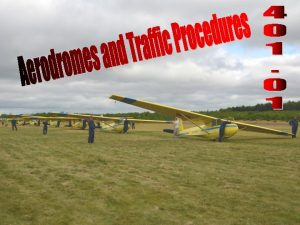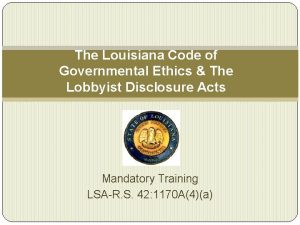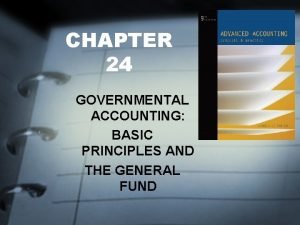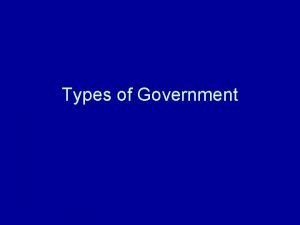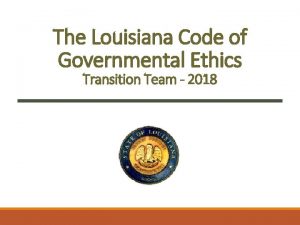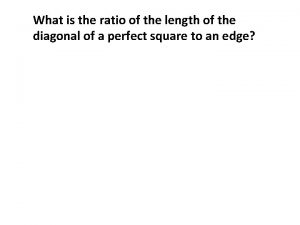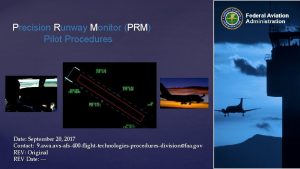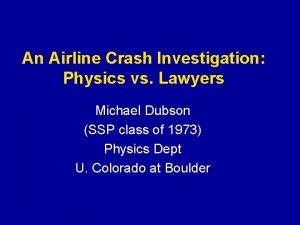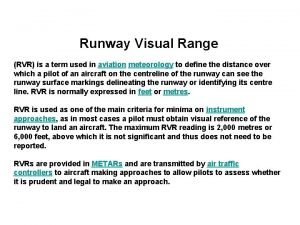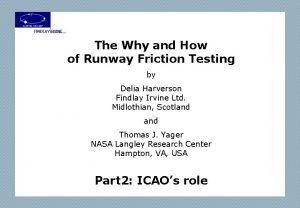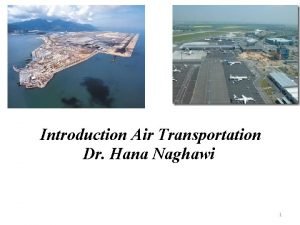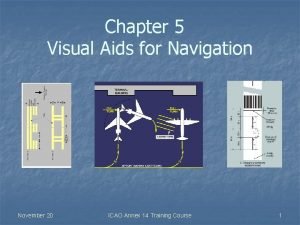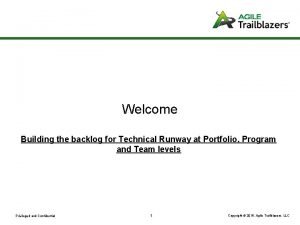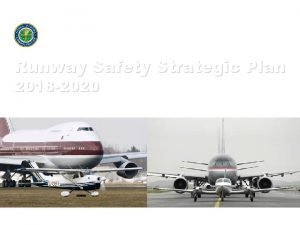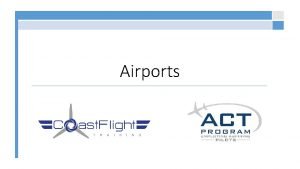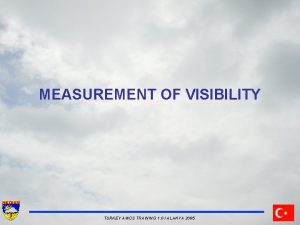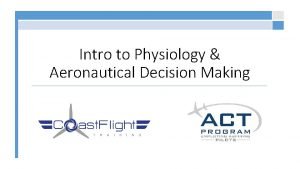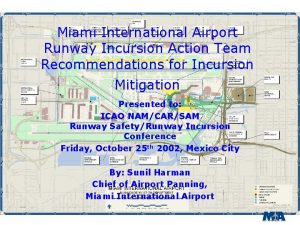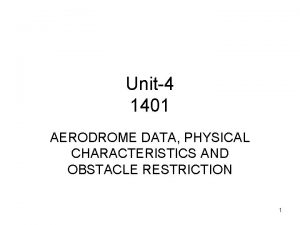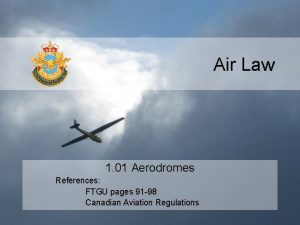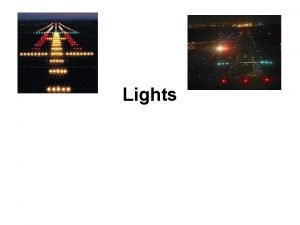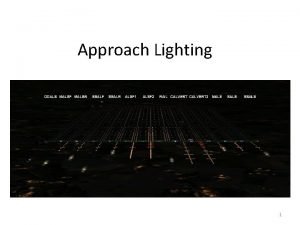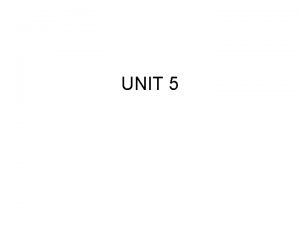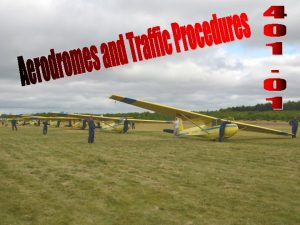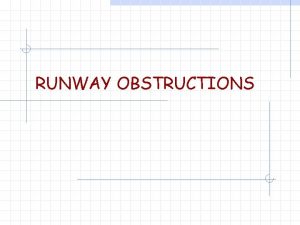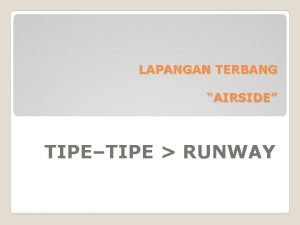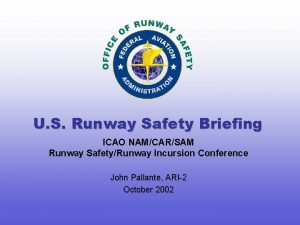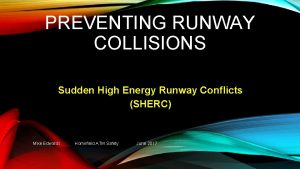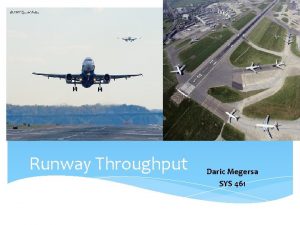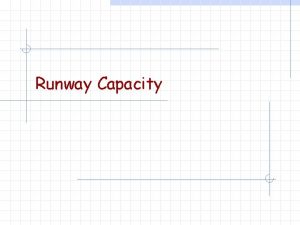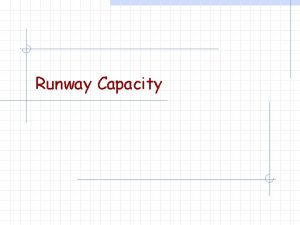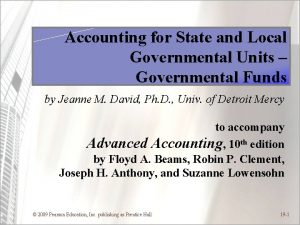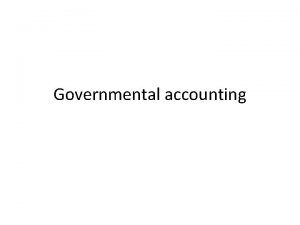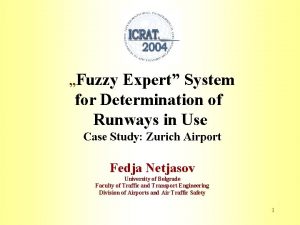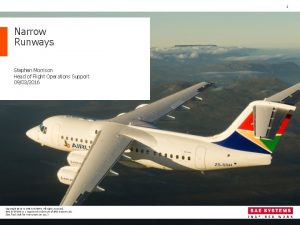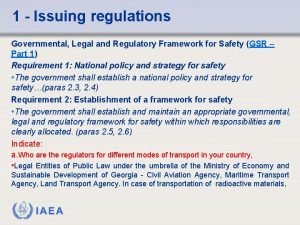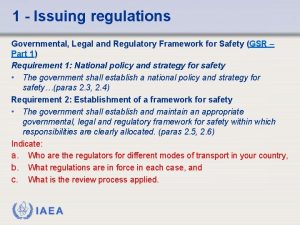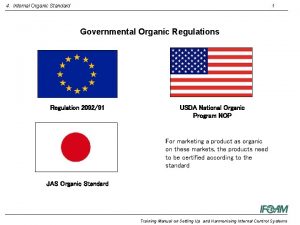RUNWAYS Runway Length Requirements w Governmental regulations w






























- Slides: 30

RUNWAYS

Runway Length Requirements w Governmental regulations w Airport location w Critical aircraft w Source: AC 150/5325 -4 B - Runway Length Requirements for Airport Design

Runway Pavement Components w Full strength (FS) l Take-off & Landing w Partial strength (PS) l Take-off w Clear Way (CL) l Take-off

Length Conditions w Normal take-off w Engine failure l l Continue take-off Abort take-off w Landing

Some Terms (see fig 3 -22) w Lift off distance (LOD) l Threshold to wheels off the ground w D 35 l Threshold to aircraft 35 feet above ground w Take off distance (TOD) l Runway length provided to D 35 with factor of safety applied = 1. 15 D 35 (for normal takeoff) w Take off roll or run (TOR) l Full strength pavement; “runway” w Accelerate and stop distance (DAS) w Landing distance (LD)

Relationship of Distances 35’ LOD D 35 TOD

Normal Take-Off 35’ LODN D 35, N TODN = 1. 15 D 35, N Clear Zone (CLN, max) = 0. 5(TODN -1. 15 LODN) TORN = TODN – CLN = FSN TODN CLN

Engine Failure, Continue Engine fails 35’ LODE D 35, E TODE = D 35, E (do not apply factor of safety) CLE, max = 0. 5(TODE - LODE) TORE = TODE – CLE = FSE TODE CLE

Engine Failure, Abort Engine fails at V=V 1 Stop DAS TODA = DAS V 1 = speed above which you continue to take off V 2 = rotation or lift off speed FSA TODA PSA

Landing Stop 50’ SD FS = “Runway” LD LD = SD/0. 6 LD = FSL

Runway Layout CL PS PS (partial strength) = SW (stopway) FS = “Runway” PS FL Field Length (FL) = max {TODN, TODE, DAS, LD} FS = max {FSN, FSE, FSL} PS = DAS – FS PSmin = 0 ft CL = min {FL-DAS, CLN, CLE} 1000 ft CLmin = 0 ft CL max= CL

Example (1/3) Distances for typical aircraft are as follows: LOD: Normal 6, 000 ft; Failure 7, 000 ft D 35: Normal 7, 000 ft; Failure 8, 200 ft DAS: 7, 900 ft and SD: 4, 500 ft. (LD = 4500/. 6=7500) Design the runway for bi-directional operations

Example Normal take-off TODN = 1. 15(7000)= 8, 050 ft (2/3) Engine failure, abort DAS = 7, 900 ft CLN, max = 0. 5(8050 -1. 15(6000)) = 575 ft FSN = 8050 -575 = 7, 475 ft Engine failure, continue Landing TODE = 8, 200 ft LD = 4500/0. 60 =7, 500 ft CLE, max = 0. 5(8200 - 7000) =600 ft FSL = 7, 500 ft FSE = 8200 - 600 = 7, 600 ft

Example (3/3) FL = max {8050, 8200, 7900, 7500} = 8, 200 ft FS = max {7475, 7600, 7500} = 7, 600 ft PS = 7900 -7600 = 300 ft CL = min {8200 -7900, 575, 600} = 300 ft 300 7600 8800 8200 300

Airport Location Adjustments w Elevation l l 7% per 1, 000 ft Fe = 0. 07 E + 1; E in 000’s w Temperature l Ft =0. 01[T –(15 -1. 981 E)]+1 w Grade l Fg = 0. 1 G +1 w Reference length (LR) – LR from before l l LR = Actual length/(Fe Ft Fg) Or, Actual length = LR*(Fe Ft Fg)

Critical Aircraft Requirements w Runway length affects l l Take-off weight Landing weight w Runway lengths l l Take off Landing

Aircraft Weights w Operating Empty Weight (OEW) l No fuel or payload w Maximum Takeoff Operating Weight (MTOW) w Maximum Landing Weight (MALW) w Maximum Structural Payload Weight (MSPW) w Maximum Zero Fuel Weight l OEW+MSPW w Fuel Weight (FW)


Range at Max structural payload Payload and range with max fuel Max range with no payload (ferry range)

Payload Range Plots Max payload and reduced range if landing load is restricted (max structural landing weight) Max range and reduced payload if landing load is restricted (max structural landing weight)

Example Problem 3 -1

Example Problem 3 -1

Example (similar to ex 3 -3) (1/8) A runway is planned for an airport at elevation 2, 300 ft AMSL and average temperature of 92 o. F. The critical aircraft is a Boeing 737 -200. Determine: 1. Runway length without weight limits 2. Weight limits for an 8, 000 ft runway

Runway length without weight limits Source: AC 150/5325 -4 A (2/8)

Example (3/8) 100. 4

Example (4/8) 69. 5

Example (5/8) 69. 5 100. 4 Runway 8, 545 ft w/0% grade MTOW 100, 400 lbs

Example (6/8) Runway 5, 650 ft w/0% grade, MLW 103, 000 lbs

Example with 8000 foot R/W 69. 5 MTOW 97, 160 lbs Runway 8, 000 ft (7/8)

Example (8/8) Distance to fly from this airport? MTOW 97, 160 lbs OEW 67, 238 lbs Pax+Fuel 29, 832 lbs 225 lbs/pax Fuel 15 lbs/mi 50 pax @ 1240 miles 60 pax @ 1090 miles 75 pax @ 860 miles
 How are runways numbered
How are runways numbered Vision, mission and objectives of ngo
Vision, mission and objectives of ngo Louisiana code of governmental ethics
Louisiana code of governmental ethics 13 basic governmental accounting principles
13 basic governmental accounting principles Role of ngos in development communication
Role of ngos in development communication Governmental systems
Governmental systems Most voluntary health agencies operate at the
Most voluntary health agencies operate at the Louisiana code of governmental ethics
Louisiana code of governmental ethics What is the ratio of the length of to the length of ?
What is the ratio of the length of to the length of ? Soia approach
Soia approach Runway excursion statistics
Runway excursion statistics Runway lights
Runway lights Runway visual range conversion
Runway visual range conversion Runway friction testing
Runway friction testing Runway numbering system
Runway numbering system Aircraft stand markings
Aircraft stand markings Architecture runway slides
Architecture runway slides Faa runway safety
Faa runway safety Pulsating vasi
Pulsating vasi Runway visual range
Runway visual range Final approach runway occupancy signal
Final approach runway occupancy signal Imsafe
Imsafe Runway incursion mitigation
Runway incursion mitigation Aerodrome data basic terminology
Aerodrome data basic terminology Loaded words
Loaded words 1000 foot markers runway
1000 foot markers runway Wing bar lights
Wing bar lights Loaded words persuasive technique
Loaded words persuasive technique Excursion in modern mathematics
Excursion in modern mathematics Red terminating bars approach light system
Red terminating bars approach light system Runway turn pad marking
Runway turn pad marking
